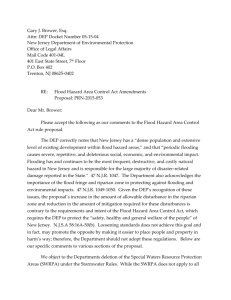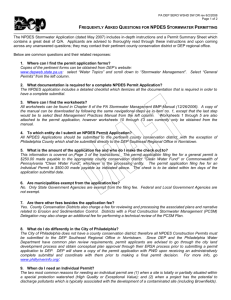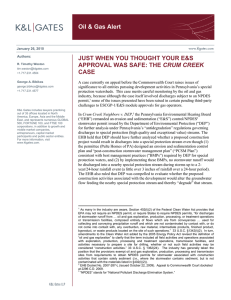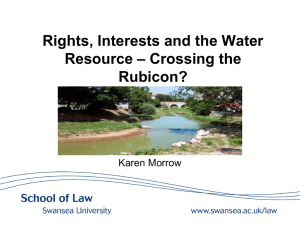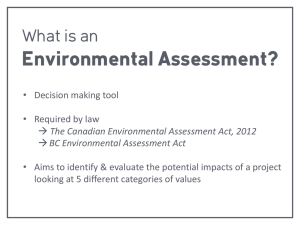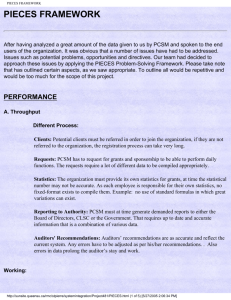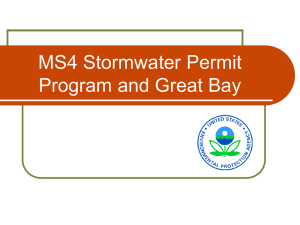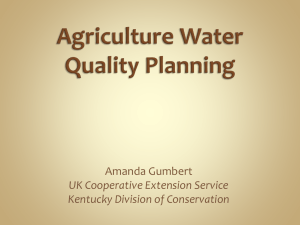Chapter 102 Changes and Highlights - AWRA-PMAS
advertisement
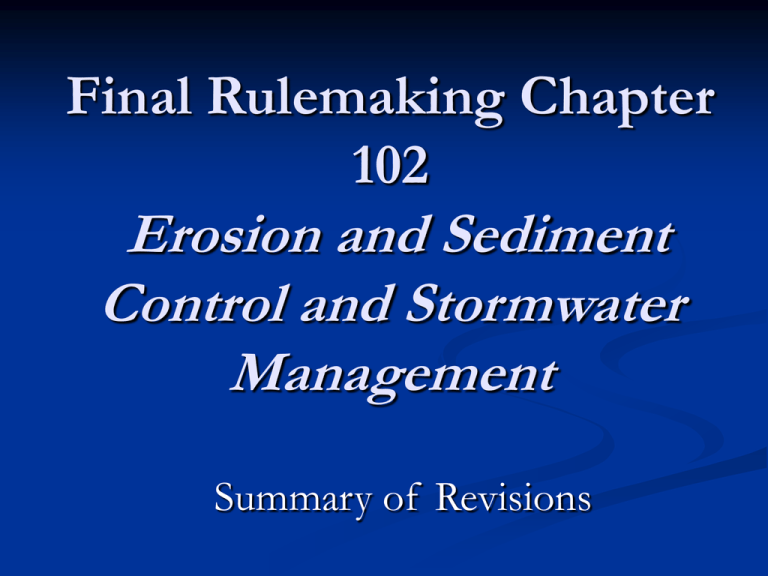
Final Rulemaking Chapter 102 Erosion and Sediment Control and Stormwater Management Summary of Revisions Why New/Revised Rulemaking? Amendments to the existing regulations. Incorporates the federal Clean Water Act “Phase II” National Pollutant Discharge Elimination System (NPDES) permit requirements for stormwater discharges associated with construction activities; Codifies post construction stormwater management (PCSM) requirements, including long-term operation and maintenance requirements of PCSM BMPs; Includes specific antidegradation implementation provisions; Updates agricultural planning and implementation requirements; Updates erosion and sediment (E&S) control requirements; and Establishes riparian buffer and riparian forest buffer provisions. Rulemaking Process Stakeholders, public and advisory committee participation played a substantial role in shaping the final form of this rulemaking. Draft rule published in Pa Bulletin on August 29, 2009. 90-day public comment period-over 1,300 commentators. 3 public hearings held Citizens (86%), environmental groups, non-governmental groups & academia (3%), industry (8%), government (federal, state agencies municipalities and conservation districts) (3%), state legislators (31 legislators from the House & Senate) and the Independent Regulatory Review Commission (IRRC). Published in Pa Bulletin as final on August 21, 2010 Effective date: 90 days or November 19, 2010 Addressing EHB Decisions DEP and regulated community unsuccessfully defending decisions Focus on implement “antidegradation” requirements, which in Pennsylvania are found in 25 Pa. Code Chapter 93. Environmental Hearing Board (EHB) decisions: Zlomsowitch v. DEP, 2004 EHB 756; Blue Mountain Preservation Association v. DEP and Alpine Rose Resorts, 2006 EHB 589; and Crum Creek Neighbors v. DEP and Pulte Homes of PA, LP, EHB Docket No. 2007287-L, October 22, 2009 EHB overturned the DEP’s current implementation of antidegradation requirements in the NPDES permits issued under this chapter. The cases identified that Chapter 102 did not provide an adequate regulatory framework for the compliance with Chapter 93. Key Definitions -102.1 ABACT- Antidegradation Best Available Control Technologies Animal Heavy Use Area Intermittent Stream Long-term Operation and Maintenance Non-discharge Alternative Oil and Gas Activities Perennial Stream Post Construction Stormwater Road Maintenance Activities Riparian Buffer and Riparian Forest Buffer Stormwater Agricultural E&S Requirements102.4 (a) A plan or BMPs must be installed for agricultural plowing and tilling and animal heavy use areas For areas under 5000 ft2, BMPs must be installed to minimize erosion and sedimentation For areas 5000 ft2 or greater, a written E&S plan is required Non-Agricultural E&S Requirements-102.4(b) For areas under 5000 ft2, BMPs must be installed to minimize erosion and sedimentation For areas 5000 ft2 or greater, a written E&S plan is required Written E&S plan also required when: Potential to discharge to special protection waters Required by other Department regulation (e.g. Chapter 105) Activities Requiring a Permit-102.5 Any construction related earth disturbance (with a few exceptions) must have an NPDES if they disturb 1 acre or greater. Timber harvesting and road maintenance activities 25 acres or greater must have an E&S permit. Oil and gas activities 5 acres or greater must have an E&S permit. All permits (NPDES and E&S) must contain PCSM plans unless provided for in other ways (discussed later) When permits are not required-102.5 Person proposing earth disturbance under another Pa. Code chapter permit (other than 92 or 102) – no additional NPDES permit under 102 Person proposing discharging dredged or fill material which is required to obtain a 404 permit – no additional NPDES permit under 102 Person proposing agricultural plowing or tilling or animal heavy use areas – no additional NPDES or E&S permit under 102 (note: does not include CAFOs or typical construction activities on a farm) Antidegradation Part of water quality standards that ensures that waters maintain their quality and uses Applicants have to examine no discharge alternatives If no discharge alternative is not feasible, then they must use ABACT ABACT must be environmentally sound and cost effective treatment, land disposal, pollution prevention and stormwater reuse BMPs that individually or collectively manage the change in rate, volume and water quality from storm events up to and including the 2-year/24-hour storm when comparing pre to post BMP definition; BMPs in DEP Manuals Preparedness, Prevention, and Contingency (PPC) Plans-102.5 Activities requiring a permit Must have a PPC plan when storing, using or transporting materials Must be made available on request of DEP or CD Fuels Chemicals Solvents Pesticides Fertilizers Lime Petrochemicals Wastewater Wash water Core drilling wastewater Cement Sanitary wastes Solid wastes Hazardous materials General Permits Other Than NPDES-102.5 DEP may develop and issue general permits regionally or statewide for category of activities not subject to NPDES requirements but regulated under this chapter if: Projects are similar in nature Projects can be regulated using standard specs and conditions, including those adopted by another Federal or State agency Projects will comply with Chapter 102 Projects individually and collectively do not have potential to cause adverse environmental impact NPDES permit authority pursuant to Chapter 92. Preconstruction Meeting-102.5 Permittee will invite DEP and CD to meeting and give at least 7 days notice of the meeting Meeting is required unless the DEP or CD inform the permittee in writing otherwise Attendants must include permittees, copermittees, operators, and licensed professionals (or designees) Licensed professionals should be the person doing the critical stages of BMP installation Permit NOIs/Applications-102.6 If NOI/application is incomplete or insufficient Notification provided in writing Applicant has 60 days to provide information If no response in 60 days, application considered withdrawn and are notified in writing Applicant can ask for extension Fees will not be returned for withdrawn application Permit Fees-102.6 E&S and NPDES permits required under Chapter 102 General Permits Individual Permits $1500 + $100/acre disturbance fee Fractional acreage - the acreage is rounded to the closest whole number Adequacy of the fees will be reviewed $500 + $100/acre disturbance fee At least once every 3 years; and A written report provided to the EQB Conservation districts may charge additional fees. Notice of Termination (NOT)-102.7 NOT must contain information on the person who agreed to and will be responsible for the PCSM long-term O&M Permittee (and co-permittee, when applicable) will remain responsible for the site and any violations on the site until written confirmation is provided DEP or CD will conduct a final inspection and act on the NOT in 30 days Post Construction Stormwater Management (PCSM) Requirements-102.8 Grandfathering provision of the PCSM responsibilities under current permit terms and conditions including Long-term O&M deeding restrictions, etc. Mandatory use of riparian buffers as a PCSM BMP PCSM Plan development, implementation and maintenance – parallel construction to E&S plan requirements Licensed professional must be present for critical stages of construction and must provide certification with NOT PCSM plan must include a riparian forest buffer management plan (when applicable) General Requirments-102.11 Establishes BMPs and design standards References DEP Manuals E&S Manual Added references for Stormwater BMP Manual, Riparian Buffer Guidance, and PPC guidance Alternative design standards Incorporated federal Effluent Limitation Guidelines (ELGs) by reference Riparian Buffers-102.14 Project site located in Special Protection (EV or HQ) watershed attaining use at the time of application: No earth disturbance within 150 of perennial or intermittent river, stream, creek, lake, pond or reservoir. Protect any existing riparian buffer. Project site located in Special Protection watershed with impaired waters (Category 4 or 5) at time of application: Protect an existing Riparian Forest Buffer. Convert an existing Riparian Buffer to a Riparian Forest Buffer. Establish a new Riparian Forest Buffer. Riparian Buffers-102.14 Standard criteria on composition, width, zones, Required as a PCSM buffer in special protection watersheds A number of exemptions and waivers are included for special situations Voluntary Trading or offsetting provision Antidegradation for waters other than special protection Temporary Stabilization-102.22 If cessation will be at least 4 days, the site must be stabilized Temporary stabilization includes Minimum uniform coverage of mulch and seed of appropriate density to resist erosion An acceptable BMP which temporarily minimizes accelerated erosion Permanent Stabilization-102.22 Shall be done on final completion or completion of any stage or phase Immediate restoration of topsoil, seeded, mulched and protected from accelerated erosion Permanent stabilization A minimum 70% uniform perennial vegetative cover with density able to resist erosion An acceptable BMP which permanently minimizes acceleration erosion and sedimentation Coordination with local government102.42, 102.43 If a municipality or county issues building permits or other permits and receives an application for a project of 1 acre or greater, they shall notify the CD or DEP within 5 days A municipality or county may not issue a building or other permit or approval until the DEP or CD has issued/authorized the permit for the project Enforcement Actions that can be pursued include: Investigations and inspections; response to complaints; orders; civil penalty proceedings; summary proceedings; suspension, revocation, withholding, or denial of permits or approvals; notices of violation; actions in court; other actions authorized by law DEP or CD can recover from the responsible party costs and expenses incurred in taking actions Person aggrieved by an action of a conservation district shall request an informal hearing with DEP; determination will be made within 30 days of the request and may be appealed to the EHB Other Related Activities NOI, NOT, Visual Inspection Form, Earth Disturbance Inspection Form, etc. Guidance documents E&S Manual Riparian Buffer Guidance Trading/Offsetting-to be developed Questions?
